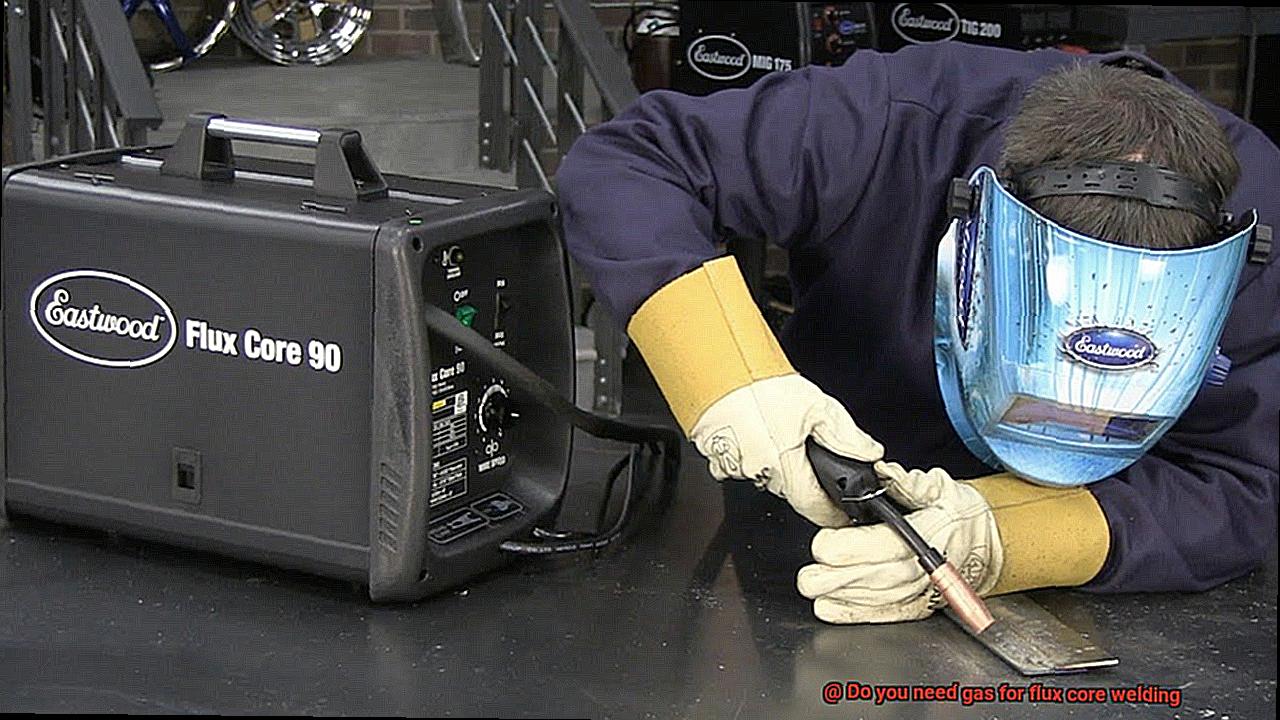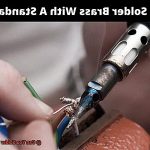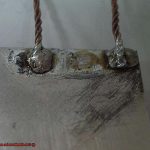Are you considering taking up flux core welding?
Wondering if gas is a must-have for the process? Flux core welding is an incredibly popular welding technique that’s known for its versatility and ease of use.
It’s perfect for welding thicker materials, and can even be done outdoors. However, one question that always crops up is whether or not you need gas for flux core welding.
The answer to this question is both ‘yes’ and ‘no.’ Flux core welding is unique in that it can be done with or without gas.
Without gas, it’s referred to as ‘self-shielded’ flux core welding. With gas, it’s called ‘gas-shielded’ flux core welding.
The choice of whether or not to use gas depends on your specific welding job requirements and preferences. In this blog post, we’ll explore the two different types of flux core welding and explain the pros and cons of each.
So, keep reading to learn more.
What is Flux Core Welding?
Contents
We’re going to explore one of the most exciting types of welding: flux core welding. If you’re new to welding, you may be curious about what exactly flux core welding is and how it works.
Well, let me enlighten you. Flux core welding is a unique and versatile welding process that uses a special type of wire electrode filled with flux.
The flux acts as a protective shield, safeguarding the weld pool from atmospheric gases that could cause oxidation or contamination. Flux core welding is similar to MIG welding, but it doesn’t require an external shielding gas.

So, do you need gas for flux core welding? It depends on your project requirements and environmental conditions.
Self-shielded flux core welding can be done without gas, while dual-shielded flux core welding requires an external shielding gas. Self-shielded flux core welding uses a flux-filled wire that generates its shielding gas when heated.
The flux creates a protective slag over the weld, preventing atmospheric gases from contaminating the weld pool. This method is ideal for outdoor welding or in windy environments where gas shielding would be difficult.
On the other hand, dual-shielded flux core welding uses both a flux-filled wire and an external shielding gas. The gas provides additional protection against atmospheric gases and can result in cleaner, higher quality welds.
This method is commonly used in indoor environments where atmospheric conditions are more controlled. One of the advantages of flux core welding is its versatility.
You can use it to weld a variety of metals, including mild steel, stainless steel, and aluminum. It’s particularly useful for outdoor welding or situations where wind can disrupt the flow of an external shielding gas.
Flux core welding can produce high-quality welds quickly and efficiently because the flux within the wire electrode creates a protective gas shield around the weld pool. In summary, whether or not you need gas for flux core welding depends on your specific project requirements and environmental conditions.
Both self-shielded and dual-shielded methods have their pros and cons, so it’s crucial to choose the right method for your job.
Do You Need Gas for Flux Core Welding?
Flux core welding is a popular method that involves using a wire electrode coated with a flux material. This material serves two essential purposes: protecting the weld from contamination and creating a shield around it to prevent oxidation.
What makes flux core welding unique is the shield created by the flux material, which eliminates the need for an external shielding gas. That being said, whether or not you need gas for flux core welding ultimately depends on your specific project requirements and environmental conditions.
Self-shielded flux core welding is ideal for outdoor or windy environments because it generates its shielding gas when heated. On the other hand, dual-shielded flux core welding requires an external shielding gas for cleaner, higher quality welds in controlled indoor environments.
Using a shielding gas with flux core welding may be beneficial in some situations. For instance, if you are working with thin metal or need to produce a particularly clean weld, using a shielding gas can help achieve better results.
Additionally, if you are working in a windy or drafty environment, using a shielding gas can prevent the shield around the weld from being disrupted. However, it’s important to note that using a shielding gas with flux core welding can interfere with the effectiveness of the flux material in some cases.
Therefore, it’s crucial to consider your specific situation and the results you want to achieve before deciding whether or not to use a shielding gas. In summary, think of using a shielding gas with flux core welding like wearing a coat in winter.
If it’s really cold outside (windy or drafty environment), then you’ll want to bundle up and wear that coat (use a shielding gas). However, if it’s just mildly chilly, then you may be able to get by without it.
Different projects require different approaches to using a shielding gas with flux core welding, just like how different coats serve various purposes (thick vs. thin). So there you have it – the answer to whether or not you need gas for flux core welding is not straightforward.
Advantages of Self-Shielded Flux Core Welding
Its unique features make it one of the most versatile and popular welding processes available today. One of the biggest advantages of self-shielded flux core welding is its portability.
With no need for an external gas supply, you can take your welding project anywhere, making it perfect for outdoor applications or remote locations where access to gas cylinders may be limited. This means that no matter where your project takes you, self-shielded flux core welding is always an option.
In addition to its portability, self-shielded flux core welding is also fast. Thanks to its higher deposition rate, you can create consistent welds more quickly than with other types of welding.
This means you can complete your project in less time without sacrificing quality. And with no need to stop and change gas cylinders, there’s less downtime and more time spent actually welding.
But don’t let speed sacrifice quality. Self-shielded flux core welding produces high-quality welds with minimal spatter.
The flux core releases shielding gases during the welding process, creating a protective barrier around the weld pool that prevents contaminants from entering. This results in cleaner and more precise welds with fewer defects.
So, not only does self-shielded flux core welding save you time, but it also ensures that your project meets the highest standards. Finally, self-shielded flux core welding is versatile and can be used on a variety of materials, including thick and heavy materials.
This makes it perfect for construction and fabrication applications where thicker materials need to be welded together. So, whether you’re working on a small project or a large-scale construction project, self-shielded flux core welding is up to the task.
So why not give it a try on your next project?
Disadvantages of Self-Shielded Flux Core Welding
Self-shielded flux core welding is often viewed as the superhero of welding processes – it’s versatile, portable, and capable of producing top-notch welds with minimal spatter.
However, like any superhero, it has its weaknesses that must be taken into account. One significant disadvantage of self-shielded flux core welding is the production of slag.
This byproduct forms as the flux material melts and solidifies during the welding process. Slag removal can be challenging, and if not done correctly, it can cause porosity in the weld and trap gases that weaken the joint.
Another issue with self-shielded flux core welding is the high amount of spatter produced. These small metal droplets can cause damage to nearby surfaces and equipment, making cleanup a bigger hassle than necessary.
In addition to these issues, self-shielded flux core welding requires a higher amperage than other types of welding processes. This increased amperage can lead to burn-through on thin materials and distortion or warping of the metal being welded.
Lastly, self-shielded flux core welding produces a significant amount of smoke and fumes during the process. These fumes can be harmful if inhaled, so proper ventilation is necessary to ensure a safe working environment.
Understanding self-shielded flux core welding’s limitations will help you deliver high-quality welds safely and efficiently.
Advantages of Dual-Shielded Flux Core Welding
This welding method is like a superhero, combining the best of both worlds by using a combination of shielding gas and flux to shield the weld puddle from contamination. One of the primary advantages of dual-shielded flux core welding is its ability to produce consistent and uniform weld beads.
With both shielding gas and flux, welders have better control over the weld pool, resulting in a stronger and more durable weld. This is especially important when working with thicker materials or in outdoor or windy conditions where welding can be challenging.
Moreover, dual-shielded flux core welding is incredibly versatile. It can be used in many applications, including shipbuilding, construction, and automotive repair.
Additionally, it produces less spatter and smoke than other types of welding, making it a cleaner and more efficient process. But perhaps one of the most significant advantages of dual-shielded flux core welding is its superior penetration capability compared to other welding methods.
It makes welding thicker materials easy and ensures that your welds will hold up under pressure. Overall, if you’re looking for a reliable welding process that can handle tough jobs with ease, dual-shielded flux core welding is your answer.
Disadvantages of Dual-Shielded Flux Core Welding
Dual-shielded flux core welding may seem like the ultimate solution to all your welding needs, but even the most powerful tools have their drawbacks.
As an expert on the subject, I’ve identified some of the disadvantages that come with this versatile welding method. One of the biggest disadvantages of dual-shielded flux core welding is the additional equipment needed.
Welders will require a gas cylinder and regulator, which increases the overall cost of the welding process. The addition of gas also makes the welding process more complex and time-consuming as welders need to ensure optimal flow rate and gas mix for successful results.
Moreover, dual-shielded flux core welding produces more fumes and smoke than other types of welding processes, posing a significant health hazard to welders who are not adequately protected with respiratory gear or working in well-ventilated areas. The fumes generated can also be harmful to nearby workers or bystanders, making necessary safety precautions essential.
Furthermore, this method may not be suitable for all types of metals or thicknesses. Welders must select the appropriate wire and gas combination carefully for each job to ensure proper penetration, fusion, and strength of the weld.
This requires extra knowledge and expertise on the part of the welder, adding to the complexity and difficulty of the process. Overall, dual-shielded flux core welding provides many benefits such as increased productivity and higher-quality welds.
However, it’s essential to consider these disadvantages before deciding whether it’s the right choice for your welding needs. Proper training, equipment, and safety precautions are fundamental for successful dual-shielded flux core welding.
In summary, while dual-shielded flux core welding may have some pitfalls, it remains a powerful tool in a welder’s arsenal. With proper preparation and training, welders can overcome these challenges and achieve fantastic results.
zozvECWvcjk” >
Conclusion
In conclusion, the answer to whether you need gas for flux core welding is that it depends on your project requirements and environmental conditions.
Flux core welding can be done with or without gas, but each method has its pros and cons. Self-shielded flux core welding is perfect for outdoor or windy environments since it generates its shielding gas when heated.
It’s portable, fast, and produces high-quality welds with minimal spatter. However, it produces slag that can be challenging to remove and causes high spatter production.
It requires higher amperage than other types of welding processes leading to burn-through on thin materials and distortion or warping of the metal being welded. Additionally, it produces significant smoke and fumes during the process.
Dual-shielded flux core welding uses both a flux-filled wire and an external shielding gas for cleaner, higher quality welds in controlled indoor environments. This method produces consistent and uniform weld beads with better control over the weld pool resulting in stronger and more durable welds.
However, it requires additional equipment such as a gas cylinder and regulator which increases the overall cost of the welding process. Therefore, choosing the right method for your job based on proper training, equipment, safety precautions while considering these advantages and disadvantages is crucial.





